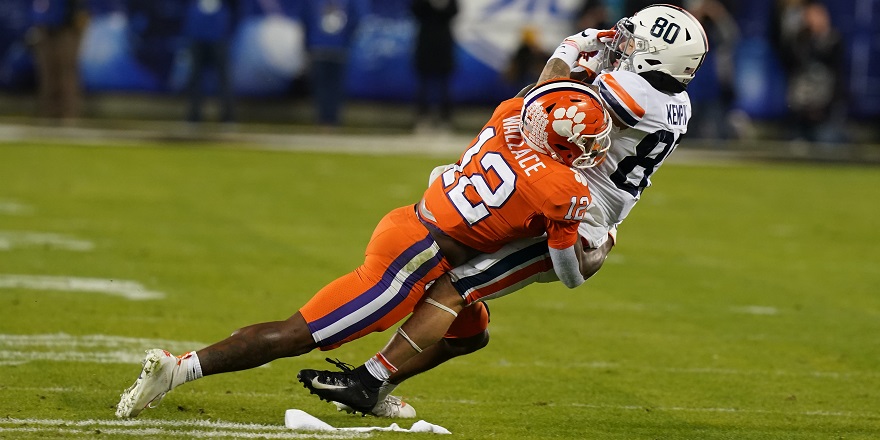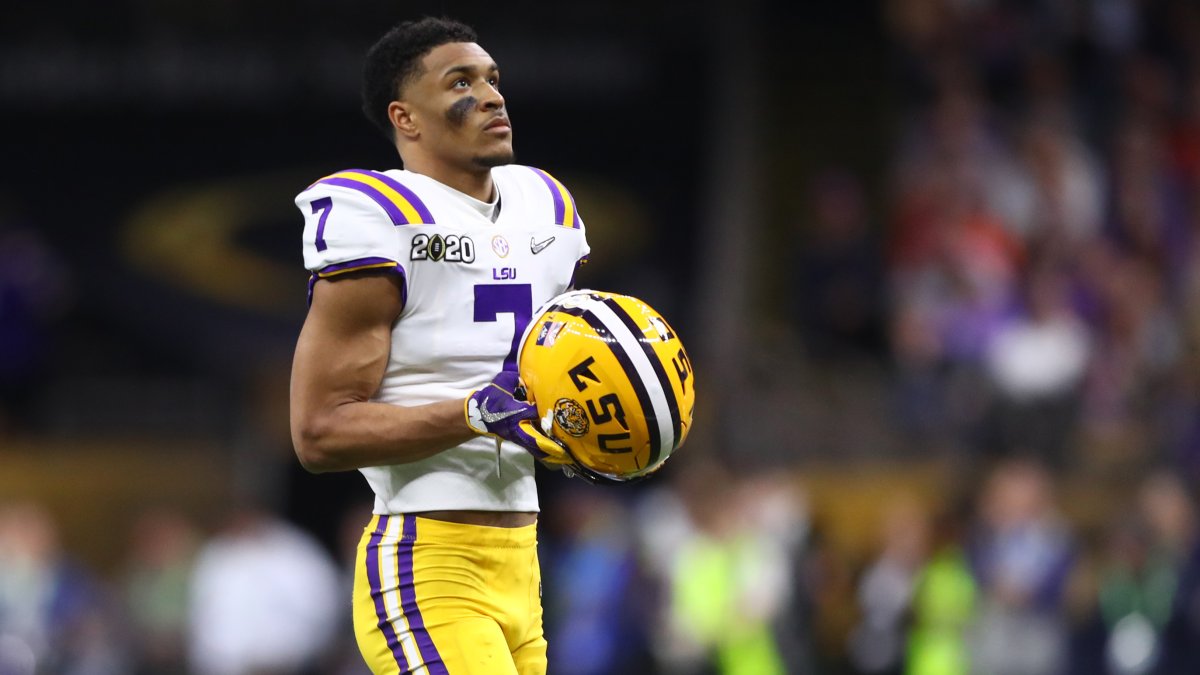This is not a banner safety class by any means. If you need one, chances are you should pull the trigger early on. There are three guys at the top who look as if they can be versatile coverage weapons off the rip, but after that there are question marks with the rest of our top-10.
[Editor's Note: PFF's 2020 NFL Draft Guide is LIVE and available to all EDGE and ELITE subscribers. Download your copy today!]
1. Grant Delpit, LSU
Draft Board Rank: 15th
Delpit has coverage ability you just can’t teach. He’s had at least six combined picks and pass breakups in every single year of his career at LSU. Some players on this list have yet to do that for a single season. Even in a “down” year in 2019, Delpit still only allowed 13-21 receiving for 196 yards and one score. At 6-3, 203 pounds, Delpit has great size for a modern safety and can execute pretty much any role asked of him.
It’s what happens after the passes have already been caught though that’s the worry with Delpit. He missed 20 tackles on 78 attempts this past season. That’s a disastrous rate. While an ankle injury is to blame for some of that, Delpit had 16 misses on 81 attempts in 2018 as well. This isn’t a new problem and may just be something you have to accept with Delpit.
2. Xavier McKinney, Alabama
Draft Board Rank: 19th
Productive and versatile, McKinney ticks two of the most important boxes in our eyes for a safety. He executed everything asked of him at Alabama the past two seasons at a high-level. He’s earned run defense grades of 79.1 and 79.4, coverage grades of 80.9 and 89.2, and pass-rush grades of 85.2 and 90.3. That’s as good a grading profile as exists at the safety position in this class. And it came from very much being a versatile piece in the Crimson Tide defense. He took 285 snaps in the box, 227 snaps from the slot, and 271 snaps deep this past season.
McKinney may not be a freakish athlete, but he’s extremely fluid. He’s made multiple picks where he’s had to turn over one shoulder, locate the ball, and then finish. Arguably his best skill is covering the slot though where his read and react ability shines though. McKinney rarely cedes an inch on the underneath route tree and plays with consistent balance.
3. Ashtyn Davis, California
Draft Board Rank: 33rd
A former track standout, Davis’ range is as good as it gets in the safety class. He’s made a handful of picks and pass breakups from the deep middle of the field over the course of his career. That’s not all he can do though, as he’s shown an ability to drop down and play man coverage against the slot or tight ends. In fact, he picked off Justin Herbert earlier this year while covering the slot.
While he’s made some big hits over the middle of the field, Davis isn’t going to be a fit as a box player in a defense. He didn’t want any part of taking on blocks at Cal and you want to keep him clean at all costs. Davis is a deep safety with the ability to come down and man the slot in a pinch.
4. Antoine Winfield Jr., Minnesota
Draft Board Rank: 38th
Winfield’s name comes with some serious injury concerns as he’s actually gotten two medical redshirts already and even though 2019 was his fourth year at Minnesota, Winfield still had two more years of eligibility. He’s been starting when healthy ever since his true freshman season though and even played some good ball way back then. The first thing you notice about Winfield is that he definitely learned to tackle from his father. He has no fear whatsoever attacking ball carriers and resembles a heat-seeking missile in the angles he takes.
The next thing you notice is that he makes some wow plays on the back end. Of his seven picks in 2019, more than a couple of them were jaw-droppers. His feel for splitting zones and breaking on deep routes looks like some of the best in the class.
5. Kyle Dugger, Lenoir-Rhyne
Draft Board Rank: 52nd
Dugger is an uber athlete. He has more raw explosiveness than any other safety in this draft class. The D2 safety hits harder than any other safety in this class either. We don’t have full grades on Dugger (yet), but from his tape at Lenoir-Rhyne, it was clear he was on another level athletically from everyone he faced. It’s tough to gauge how his feel is for the safety position against that competition, but we saw his absurd range and tackling ability translate at the Senior Bowl practices.
6. Geno Stone, Iowa
Draft Board Rank: 53rd
Stone may be undersized, but he is one of the headiest safeties in the draft class. If you play defensive back at Iowa, chances are you have exceptional zone instincts and that’s the case with Stone. He’ll break on passes without even seeing the QB cock to throw at times. He earned coverage grades of 89.8 in 2018 and 84.5 this past season. For his career, Stone has only allowed a passer rating of 44.0 in his coverage. Not yet 21 years old, Stone shouldn’t be this good at such a complex position this young. Add in the fact that he’s a plus athlete across the board and it’s easy to see why we’re high on him.
7. Terrell Burgess, Utah
Draft Board Rank: 57th
Burgess is a one-year wonder for the Utes, as he never played more than 222 snaps in a season prior to 2019. This year he broke out with a 90.4 coverage grade as he allowed only 26-40 receiving for 190 yards and no scores. His most coveted skill will be his ability to come up and play press-man on the slot or tight ends. Burgess could have easily passed for a corner with how adept he was in the one-on-ones at the Senior Bowl.
Not only is his one year of productivity concerning, but also his size elicits worry. He checked in at 192 pounds at the Senior Bowl with only a 72-inch wingspan — both those figures were the lowest of any safety in attendance. Undersized with limited length is a bad combo to have when projecting to the NFL. It’s not impossible to overcome, but his testing will be important at the combine.
8. K’Von Wallace, Clemson
Draft Board Rank: 60th

Wallace is listed with the safeties here, but in actuality, he’s a pure slot cornerback. While that’s limiting his value to some degree as most slot corners aren’t yet full-time players in the NFL, Wallace looks like the best pure slot in the class. He earned an 89.7 coverage grade this past season as his 47 targets only resulted in 13 first downs. He’s a solidly built 199 pounds and has been an excellent tackler for his career. The Clemson defensive back has missed only 13 tackles on 159 attempts over the past three years.
One thing Wallace needs to work on are his hands. He’s dropped eight picks over the past two seasons, the most by any player in college football over that span. Odds are that’s more fluke than projectable skill, but it’s interesting nonetheless.
9. Kenny Robinson Jr., West Virginia/St. Louis Battlehawks
Draft Board Rank: 90th
Robinson was one of the top safeties on our board heading into the 2019 season, but that 2019 season ultimately never materialized. He entered the transfer portal after leaving West Virginia but ended up in the XFL instead. Once he was there, we still saw those ball hawk qualities, as he picked off two passes in five games to give him nine picks in 28 games between West Virginia and the XFL. He’s got a bit of a reckless streak on the back end, but if a defensive coordinator can reel him in, Robinson has all the talent to continue making plays in the NFL.
10. Jeremy Chinn, Southern Illinois
Draft Board Rank: 107th
Chinn certainly falls into the “uber athlete” category of defenders. The competition he played against may not be great, and he may not have a clean positional projection at the NFL level, but he’s too freaky not to take a chance on. And it’s not solely because of the ridiculous explosiveness we saw at the Combine, either (4.45 40, 41-inch vertical, 11-foot-6 broad jump), as his tape shows smooth hips and agility, as well. The worry is for all that athleticism, he was far from a playmaker at SIU, and that explosiveness didn’t show up snap after snap.



 © 2025 PFF - all rights reserved.
© 2025 PFF - all rights reserved.